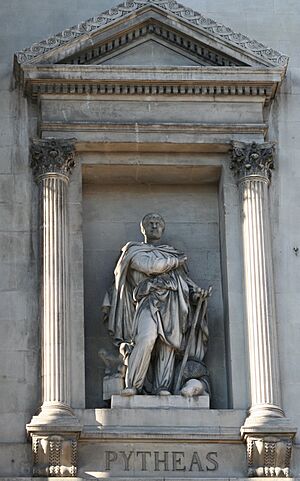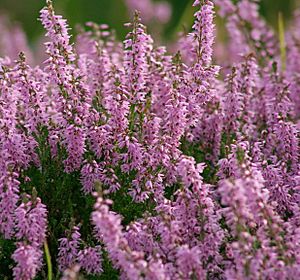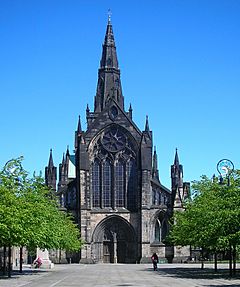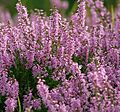Great Britain facts for kids
|
Other native names
Breten Veur (Cornish)
Great Breetain (Scots) Breatainn Mhòr (Scottish Gaelic) Prydain Fawr (Welsh) Albion |
|
|---|---|
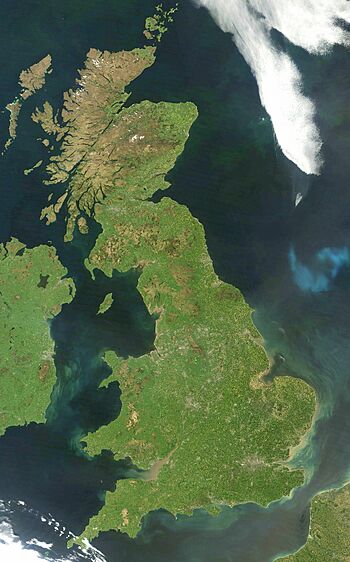
|
|
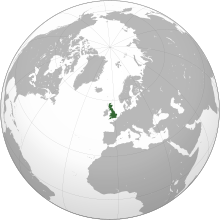 |
|
| Geography | |
| Location | North-western Europe |
| Coordinates | 54°N 2°W / 54°N 2°W |
| Archipelago | British Isles |
| Adjacent bodies of water | Atlantic Ocean |
| Area | 209,331 km2 (80,823 sq mi) |
| Area rank | 9th |
| Highest elevation | 1,345 m (4,413 ft) |
| Highest point | Ben Nevis, Scotland |
| Administration | |
| Countries | |
| Largest city | London (pop. 8,866,180 in 2022) |
| Demographics | |
| Population | 65,685,738 (2022) |
| Population rank | 3rd |
| Pop. density | 287 /km2 (743 /sq mi) |
| Languages | |
| Ethnic groups | |
| Additional information | |
| Time zone | |
| • Summer (DST) | |
Great Britain (often called Britain) is a large island in the North Atlantic Ocean. It sits off the north-west coast of continental Europe. This island is home to three countries: England, Scotland, and Wales.
Great Britain covers about 209,331 square kilometers (80,823 square miles). It is the biggest island in the British Isles. It is also the largest island in Europe and the ninth-largest island in the world. The weather here is mostly maritime, meaning temperatures don't change much between seasons.
The island of Ireland is to the west. It is about 40% the size of Great Britain. These two main islands, along with over 1,000 smaller islands, make up the British Isles.
Great Britain was connected to mainland Europe by a landbridge called Doggerland until about 9,000 years ago. Modern humans have lived here for around 30,000 years. In 2011, about 61 million people lived on the island. This makes it the world's third most populated island. Only Honshu in Japan and Java in Indonesia have more people. It is the most populated island outside of Asia.
The name "Great Britain" can also mean the political area of England, Scotland, and Wales. This includes their smaller islands nearby. This area, along with Northern Ireland, forms the United Kingdom.
Contents
Understanding the Name: What Does "Great Britain" Mean?
How the Name "Britain" Came About
The group of islands has been known by one name for over 2,000 years. The name 'British Isles' comes from terms used by ancient geographers. Around 50 BC, Greek geographers used names like Prettanikē for these islands. Later, when the Romans arrived, they used the Latin name Britannia for the island of Great Britain. This name was later used for the Roman-controlled parts of Britain, south of Caledonia (modern Scotland).
The oldest known name for Great Britain is Albion. This name might come from the Latin word albus, meaning "white." This could refer to the white cliffs of Dover, which are often the first part of Britain seen from Europe. The Greek philosopher Aristotle (or someone writing under his name) mentioned "Albion" and "Ierne" (Ireland) as the two large British Isles.
The first time the word "Britain" was written down was by the Greek explorer Pytheas of Massalia. He traveled to Britain around 320 BC. Later writers like Pliny the Elder mentioned that the island was once called Albion. But later, all the islands were called 'Britanniæ'.
The name Britain comes from the Latin word Britannia. This means "land of the Britons." The people of these islands were called the Priteni or Pretani. This word might mean "the painted ones" or "the tattooed folk." This could refer to their body decorations.
Why is it Called "Great" Britain?
The word "Great" was added to "Britain" to tell it apart from other places. The Greek-Egyptian scientist Ptolemy called the larger island great Britain. He called Ireland little Britain around 147 AD.
Later, in the 12th century, Geoffrey of Monmouth used "Greater Britain" to distinguish it from "Lesser Britain." Lesser Britain was a region in Europe that is now Brittany in France. Many Celtic people from Great Britain had moved there.
The term Great Britain was first used officially in 1474. This was for a marriage proposal between the royal families of England and Scotland. In 1604, King James, who ruled both England and Scotland, called himself "King of Great Brittaine, France and Ireland."
Modern Use of the Term "Great Britain"
Today, Great Britain usually means the island itself. Politically, it can mean England, Scotland, and Wales, including their smaller islands. It's not quite right to use "Great Britain" for the whole United Kingdom. The United Kingdom also includes Northern Ireland. However, people sometimes use the term loosely.
Similarly, Britain can refer to the whole group of islands, the largest island, or the political group of countries. Even government documents sometimes use "Britain" and "United Kingdom" without a clear difference.
You might see "GB" or "GBR" used for the United Kingdom in some international codes. This happens in sports teams, postal services, and other organizations. For example, the British Olympic Association uses Team GB for the British Olympic team.
History of Great Britain
Ancient Times: Prehistoric Britain
The oldest signs of humans in Britain are footprints and stone tools. They were found in Norfolk and are about 950,000 to 850,000 years old. Before 450,000 years ago, Britain was connected to mainland Europe. Then, huge floods created the English Channel. Britain became an island during warmer periods.
Modern humans arrived in Britain around 40,000 years ago. This was after Neanderthals disappeared. Before 9,000 years ago, Britain was still connected to Europe by a land bridge called Doggerland. This area is now under the North Sea.
During the Mesolithic period, hunter-gatherers lived in Britain. Around 4000 BC, farmers from Anatolia (modern Turkey) arrived. They replaced the hunter-gatherers. Later, around 2000 BC, the Bell Beaker Culture came to Britain. This led to another big change in the population. Celtic languages may have arrived around 1000 BC. During the Iron Age, different Celtic tribes lived in Britain.
Roman and Medieval Periods
The Romans conquered most of the island, up to Hadrian's Wall in northern England. This area became the Roman province of Britannia. After the Roman Empire fell, Germanic tribes like the Angles, Saxons, and Jutes invaded. They settled in the south and east. The native Britons were either absorbed or moved away.
At the same time, Gaelic tribes from Ireland moved into the north-west. They mixed with the Picts and Britons of northern Britain. This eventually led to the Kingdom of Scotland in the 9th century. The people in south-east Britain became known as the English people.
The Germanic speakers called the Britons "Welsh." This name now only refers to people from Wales. However, it also appears in names like Wallace and Cornwall. The Britons who lived in Wales, Cumbria, and Cornwall were not taken over by the Germanic tribes. This is why Celtic languages survived in these areas. Many Britons also moved to Brittany in France.
In the 9th century, Danish attacks led to parts of northern England being controlled by Danes. This area was called the Danelaw. But in the 10th century, all the English kingdoms united under one ruler. In 1066, England was conquered by the Normans. They brought a Norman-speaking government, which later blended in. Wales came under Norman control in 1282 and officially joined England in the 16th century.
Early Modern Period: Uniting the Crowns
On October 20, 1604, King James became king of both England and Scotland. He declared himself "King of Great Brittaine, France, and Ireland." Even though he used this title, England and Scotland remained separate countries with their own parliaments.
This changed in 1707. Both parliaments passed an Act of Union. This created a single kingdom with one parliament. The new all-island state was named "Great Britain." It was described as "One Kingdom" and "the United Kingdom." So, the state that existed between 1707 and 1800 is known as "Great Britain" or the "Kingdom of Great Britain."
Geography of Great Britain
Great Britain is located on the European continental shelf. It is separated from mainland Europe by the North Sea and the English Channel. The Channel is narrowest at the Straits of Dover, only about 34 kilometers (21 miles) wide. The island stretches about ten degrees north to south.
To its west, the North Channel, Irish Sea, St George's Channel, and Celtic Sea separate it from the island of Ireland. Since 1993, Great Britain has been connected to Europe by the Channel Tunnel. This is the longest undersea rail tunnel in the world.
The eastern and southern parts of the island have low, rolling countryside. The western and northern parts have more hills and mountains. Over 1,000 smaller islands and islets surround Great Britain. The longest distance across the island is about 601.5 miles (968 kilometers) by road. This is from Land's End in Cornwall to John o' Groats in Caithness.
The English Channel was likely formed between 450,000 and 180,000 years ago. It was created by two huge floods from a large glacial lake. Around 10,000 years ago, during the last ice age, sea levels were much lower. Great Britain was not an island then. It was a high area of north-western Europe, partly covered by ice. The North Sea bed was dry, forming a land bridge called Doggerland. As sea levels rose after the ice age, Doggerland was flooded. This cut off Britain from Europe around 6500 BC.
Geological Features of Great Britain
Great Britain's rocks have been shaped by many plate tectonic processes over a very long time. Changes in latitude and sea levels have affected the types of rocks formed. Collisions between continents have also created major faults and folds. This has led to a rich variety of landscapes across the island.
The oldest rocks are the Lewisian gneisses. These are found in the far north-west and in the Hebrides. They are at least 2.7 billion years old. South of these, in the Scottish Highlands, are folded sedimentary rocks. These were laid down between 1 billion and 670 million years ago.
Today, the north of the island is slowly rising. This is because the weight of the ice from the last ice age has been lifted. In contrast, the south and east are sinking. This is usually about 1 millimeter (1/25 inch) per year. The London area is sinking twice as fast. This is partly due to the settling of recent clay deposits.
Animal Life: Fauna of Great Britain
Great Britain has a moderate variety of animals. This is because the island is small. Also, its habitats are relatively new since the last ice age. Its separation from Europe and changing seasons also play a role. Early industrialisation and ongoing urbanisation have also caused some species to be lost. A study in 2006 suggested that 100 species became extinct in the UK during the 20th century.

Rodents make up 40% of the mammal species. These include squirrels, mice, voles, rats, and the recently reintroduced European beaver. You can also find many rabbits, hares, shrews, moles, and several types of bat.
Carnivorous mammals include the red fox, badger, otter, weasel, stoat, and the rare Scottish wildcat. Various types of seal, whale, and dolphin live around Britain's coasts. The largest wild land animals are deer. The red deer is the biggest. Roe deer and fallow deer are also common.
Many species have been affected by habitat loss. Large mammals that are now extinct include the brown bear, grey wolf, and wild boar. Wild boar have been reintroduced in some areas recently.
There is a lot of birdlife, with 628 species recorded. Of these, 258 breed on the island or stay during winter. Because of its mild winters, Great Britain hosts many wintering birds. These include waders, ducks, geese, and swans. Other well-known birds include the golden eagle, grey heron, common kingfisher, European robin, and various types of crow, finch, and owl.
There are six species of reptile: three snakes and three lizards. The adder is a venomous snake, but it rarely causes death. Amphibians include frogs, toads, and newts.
Plant Life: Flora of Great Britain
Like animals, Great Britain has fewer plant species compared to larger parts of Europe. This is for similar reasons. The island has 3,354 vascular plant species. Of these, 2,297 are native, and 1,057 have been introduced.
The island has many types of trees. Native species include birch, beech, ash, hawthorn, elm, oak, yew, pine, cherry, and apple. Other trees have been introduced from Europe and North America. These include different types of pine, chestnut, maple, spruce, and sycamore. The tallest trees are Douglas firs, with some reaching 65 meters (212 feet). The Fortingall Yew in Perthshire is the oldest tree in Europe.
There are at least 1,500 different species of wildflower. About 107 species are rare or vulnerable and are protected by law. It is against the law to dig up any wildflowers without the landowner's permission.
Some popular wildflowers include red poppies, bluebells, daisies, daffodils, gorse, and thistles. There are also over 1,000 species of bryophytes, including algae and mosses. This includes 767 mosses, 298 liverworts, and 4 hornworts.
Fungi: The Hidden Kingdom
Great Britain has many species of fungi, including those that form lichen. Scientists are still discovering many new types of fungi. The most recent list of Basidiomycota (like mushrooms and toadstools) from 2005 includes over 3,600 species. Another list from 1985 for Ascomycota (like cup fungi) includes 5,100 species. Many more are believed to exist.
People and Places: Demographics of Great Britain
Major Cities and Settlements
London is the capital of England and the entire United Kingdom. It is where the UK government is based. Edinburgh is the capital of Scotland. It is home to the Scottish Government and Scotland's highest courts. The Palace of Holyroodhouse in Edinburgh is where the British monarch stays when in Scotland. Cardiff is the capital of Wales and where the Welsh Government is located.
Here are some of the largest urban areas in Great Britain:
| Rank | City-region | Built-up area | Population (2011 Census) |
Area (km2) |
Density (people/km2) |
|---|---|---|---|---|---|
| 1 | London | Greater London | 9,787,426 | 1,737.9 | 5,630 |
| 2 | Manchester–Salford | Greater Manchester | 2,553,379 | 630.3 | 4,051 |
| 3 | Birmingham–Wolverhampton | West Midlands | 2,440,986 | 598.9 | 4,076 |
| 4 | Leeds–Bradford | West Yorkshire | 1,777,934 | 487.8 | 3,645 |
| 5 | Glasgow | Greater Glasgow | 1,209,143 | 368.5 | 3,390 |
| 6 | Liverpool | Liverpool | 864,122 | 199.6 | 4,329 |
| 7 | Southampton–Portsmouth | South Hampshire | 855,569 | 192.0 | 4,455 |
| 8 | Newcastle upon Tyne–Sunderland | Tyneside | 774,891 | 180.5 | 4,292 |
| 9 | Nottingham | Nottingham | 729,977 | 176.4 | 4,139 |
| 10 | Sheffield | Sheffield | 685,368 | 167.5 | 4,092 |
Languages Spoken in Great Britain
In the Late Bronze Age, Britain was part of the Atlantic Bronze Age culture. This culture was connected by sea trade. It also included Ireland, France, Spain, and Portugal.
All modern Brythonic languages (Breton, Cornish, Welsh) come from a common language called Brittonic. This language developed from Proto-Celtic by the 6th century AD. Brythonic languages were likely spoken across most of Great Britain south of the rivers Forth and Clyde before the Roman invasion. During the Roman occupation, Common Brythonic borrowed many Latin words. About 800 of these Latin words are still used in modern Brythonic languages.
Today, British English is spoken across the island. It developed from Old English, which was brought by Anglo-Saxon settlers from the mid-5th century. About 1.5 million people speak Scots, which is a native language of Scotland. Around 700,000 people speak Welsh, which is an official language in Wales. In parts of north-west Scotland, Scottish Gaelic is still widely spoken. There are also many regional dialects of English and languages spoken by immigrant groups.
Religion in Great Britain
Christianity has been the largest religion in Great Britain since the Early Middle Ages. It was brought by the ancient Romans and developed into Celtic Christianity. According to tradition, Christianity arrived in the 1st or 2nd century.
The most common form of Christianity is Anglicanism. This began with the English Reformation in the 16th century. It sees itself as both Catholic and Reformed. The monarch of the United Kingdom is the head of the Church of England. It is the official church in England. Today, there are over 26 million Anglicans in Britain.
The second largest Christian group is the Latin Church of the Catholic Church. Its history goes back to the 6th century with Augustine of Canterbury. It was the main religion for about a thousand years. Today, there are over 5 million Catholics in Great Britain.
The Church of Scotland is the third largest Christian group. It is a form of Protestantism with a Presbyterian system. It has the status of a national church in Scotland. Methodism is the fourth largest. It grew from Anglicanism through John Wesley. The Presbyterian Church of Wales is the largest denomination in Wales. There are also other Christian groups like Baptists and Quakers.
The first patron saint of Great Britain was Saint Alban. He was the first Christian martyr from the Roman-British period. He was killed for his faith.
The three countries of the United Kingdom have patron saints:
- Saint George for England
- Saint Andrew for Scotland
- Saint David for Wales
Many other religions are practiced in Great Britain. The 2011 census showed that Islam had about 2.7 million followers. More than 1.4 million people follow Hinduism, Sikhism, or Buddhism. Judaism had about 263,000 followers. Jews have lived in Britain since 1070. However, they were expelled from England in 1290 and allowed to return in 1656. Many Jews in Great Britain have ancestors who fled from persecution.
Images for kids
-
Greek geographer, Pytheas of Massalia
-
A 1490 Italian reconstruction of the relevant map of Ptolemy who combined the lines of roads and of the coasting expeditions during the first century of Roman occupation. Two great faults, however, are an eastward-projecting Scotland and none of Ireland seen to be at the same latitude of Wales, which may have been if Ptolemy used Pytheas' measurements of latitude. Whether he did so is a much debated issue. This "copy" appears in blue below.
-
Prima Europe tabula. A copy of Ptolemy's 2nd-century map of Roman Britain. See notes to image above.
-
The robin is popularly known as "Britain's favourite bird".
-
Canterbury Cathedral, seat of the Church of England –the island's largest denomination
-
Glasgow Cathedral, a meeting place of the Church of Scotland
See also
 In Spanish: Gran Bretaña para niños
In Spanish: Gran Bretaña para niños


